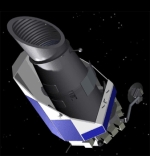
Imagine a mosquito flying in front of a car headlight.
You couldn’t see the mosquito, but if you had a sensitive
light detector you could measure a tiny drop in the brightness
of the headlight as the mosquito flew by. This is what the
Kepler spacecraft will do as it searches for planets orbiting
in front of their host stars. The passage of a planet in
front of its star is called a transit. This tells
astronomers more than you might think! If you plot a line
on a  graph of the amount of light being emitted by the star,
the passage of a planet in front of the star is signaled
by a dip in the line: the deeper the dip, the bigger the
planet or the closer it is to its star. How often the same
dip occurs tells you how long the planet takes to orbit the
star. Once you know this, you can tell how far the planet
is from the star.
graph of the amount of light being emitted by the star,
the passage of a planet in front of the star is signaled
by a dip in the line: the deeper the dip, the bigger the
planet or the closer it is to its star. How often the same
dip occurs tells you how long the planet takes to orbit the
star. Once you know this, you can tell how far the planet
is from the star.
One of the greatest astronomers in history, Johannes Kepler
(1571-1630) formulated the laws of planetary motion. He was
the first person to predict that Mercury and Venus would
transit the  Sun. The Kepler spacecraft is named in his honor.
Sun. The Kepler spacecraft is named in his honor.
Using the transit technique, the Kepler spacecraft will
search for Earth-sized planets in Earth-like orbits around
at least 100,000 stars in the constellation Cygnus—still
only a small portion of our Milky Way galaxy. Kepler is scheduled
for launch in late 2007.



